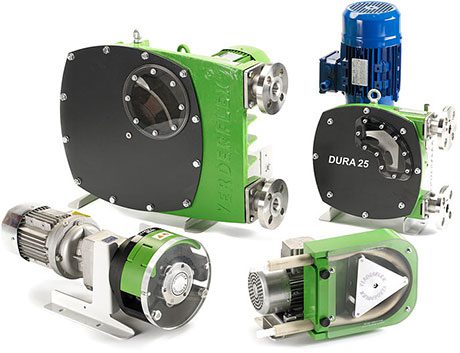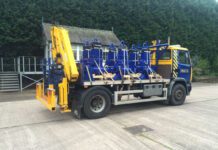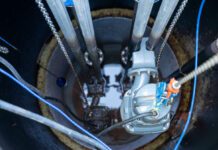By design, the peristaltic pump is ideal for the dependable handling of abrasive, corrosive, viscous, high density and high solid content fluids. It thrives in those applications where other types of pump fail. Water and waste water industries, mining and chemical processing are all prime markets for this workhorse. But being equal to the tough demands of these applications is far from its only strength. The peristaltic pump can also be extremely versatile.
Different hose and tube options allow this pump to handle an exceptionally wide range of fluids, there’s also a huge choice of flow rates and pressures to suit almost every application. And perhaps somewhat overshadowed by its dominance in heavy-duty slurry and sludge handling, is the peristaltic pump’s eminent suitability for handling shear sensitive products. It has a smooth, squeezing action that makes it ideal for use with flocculants, sensitive polymers and fragile cell cultures.
The growing awareness of the peristaltic pump’s wider potential is leading to its increased use in less arduous fields of application. It is regularly specified by the printing and packaging industries in place of air diaphragm pumps as it is gentle on the product but still able, for example, to handle viscous metallic inks. The food, drink and pharmaceutical industries are also regularly installing this type of pump. This is because the pumped product is isolated from the workings, there’s no danger of contamination and it’s easy to sterilise.
Another key factor in the rising popularity of the peristaltic pump is its fit-and-forget quality. Its lack of valves, seals and glands makes it inexpensive to maintain. Indeed the only replacement part on a peristaltic pump is the hose or tube, a relatively low cost item that is easily exchanged. These are important qualities as companies strive to optimise production processes and minimise costly downtime.

Design basics
In order to expand on why a peristaltic pump is the best choice for a wide spectrum of applications, we first need to consider the design principles. Key to its success is the fact that the medium being pumped is completely contained within a reinforced hose. A rotating shoe or roller passes along the length of the hose creating a total seal between the suction and discharge sides of the pump.
As the pump’s rotor turns, this sealing pressure moves along the hose forcing the product to move from the pump and into the discharge line. When the pressure has been released, the hose recovers creating a vacuum which draws the product into the suction side of the pump, the priming mechanism. Combining these suction and discharge actions results in a self-priming positive displacement pump.
The advantages of this design are numerous. The perfect seal between the two sides of the pump means that there is no product slip. And when coupled with the pump’s linear speed-flow characteristic, it makes the peristaltic pump ideal for dosing. Additionally, as the pumped liquid is totally contained within the hose or tube, the design is of considerable benefit to hygiene conscious applications. The total containment of the fluid has the added advantage that no moving parts can clog or react with chemically aggressive fluids.
High tech hoses
Developments in tube and hose technology have a significant role in the peristaltic pump’s wide application scope and high reliability. The choice includes resistance to high temperatures, corrosive chemicals, oils, fuels, solvent and mineral acids and of course includes special grades for food, drink and pharmaceutical handling tasks.
Advances have also been made in the way hoses are manufactured. Historically hoses would fail due to early fatigue. The rubber layers and the reinforcement layer become dis-bonded, a process that is often accelerated by externally machining the hose to achieve equal wall thickness. However, a new hose production process has been developed by some manufacturers. This ensures a uniform wall thickness without the need for secondary machining and this significantly extends the service life of the hose.
Traditional markets
Abrasive mining slurries have sub-micron, solid contents in excess of 80% with specific gravity ratings of 2.0. Handling such a medium is a classic application for a peristaltic hose pump. Indeed it is the only pump type able to cope with such dense fluids whilst maintaining high levels of plant availability.
The variable nature of the corrosive reagents causes diaphragm pumps to clog. This leads to increased chemical usage and lower plant efficiency. Progressive cavity pumps present no solution as they often suffer from burnt stators as they are allowed to run dry. The failings of other pump technologies have led to wide take-up of peristaltic pumps in these tough environments.
There is however no need to dwell on the peristaltic pump’s merits in the arduous end of the applications market. Its case is proven. It scores over other designs in many ways. Let’s look instead at some applications where the peristaltic pump isn’t the most obvious choice but has demonstrated itself to be the ideal product for the job.
Paper residues
The peristaltic pump’s ability to run dry with no adverse effect gives it an advantage for many applications. One is in paper manufacture. It is an industry that also processes a large amount of waste water that can contain residues such as fibrous substances, fillers and chemicals.
As the fluid tends to clog when only low flow rates are needed, the efficient working of other pump types is compromised. The low maintenance credentials of a peristaltic pump make it the perfect choice. When the fluid clogs at the suction side, as can happen easily with this application, the simple reverse action of the rotor is the easy solution to the problem.
Bubble-free ink
Ink handling is another growing application area for peristaltic pumps. A good example in this sector comes from a packaging company that had been using air diaphragm pumps to transfer ink from storage containers to printing machines. However production problems were resulting from the existing pumps’ inability to handle the water-based ink gently enough. As a result, bubbles formed in the ink, ruining the packaging, creating waste and adding expense.
A compact peristaltic hose pump proved to be the ideal solution. Ink is dosed gently, eliminating bubbles and as the ink is completely contained within the pump’s hose throughout the process there is no mess or wear to moving parts. Colour change is quickly accomplished as the hose is easily exchanged. The pump itself can even run dry without fear of damage.
Yeast pumping
Pumps with a high shear-rate can damage a fragile product such as yeast and compromise its quality. This can lead to reduced production efficiency. The viscosity of yeast can also vary significantly during a typical production run, going from the consistency of water to several thousand Centipoise and this can cause problems for some pumps.
Additionally, the abrasive nature of yeast can lead to stator or impeller wear resulting in costly downtime, loss of production and ongoing maintenance costs. Another common pumping problem is the result of active yeast producing gas. This can also cause some pumps to vapour lock, reducing output.
All of these issues are easily resolved with the use of peristaltic pumps that are able to handle viscous and abrasive media with a low shear pumping action and are not susceptible to vapour locking.
Drug administration
At the lighter duty end of the scale peristaltic tube pumps are proving popular for accurate and reliable dosing. A typical application is a fast and automatic method of administering methadone to recovering drug addicts. Indeed a key benefit of the system is the elimination of human error as an incorrect dose of this substance could prove fatal to the patient.
The design of the peristaltic pump internal backflow for accurate dosing without slip and ensures the high degree of repeatability required by legislature such as The Medicines Acts within the UK. Hygienic dispensing is guaranteed as the methadone is contained fully in the tube which was specified to be resistant to the methadone’s acidity. The simplicity of the pump design makes it easy and quick to exchange the tube in the pharmacy. No special tools or training is required and the used tubing can be safely disposed of.
Sub-zero drinks dispensing
The vending machine industry is an established user of peristaltic tube pumps but an installation in sub-zero temperatures demonstrates the benefits of the design particularly well.
In cold climates chocolate syrup used by a vending machine to make a cup of hot chocolate becomes highly viscous. So, to deliver the correct measure, in hygienic conditions and at a consistent flow rate the OEM chose a bespoke peristaltic tube pump. In this case a dovetail section silicone tube was specified that is suitable for high temperature fluids.
Peristaltic tube pumps with high suction capability are readily available. Standard models will lift a liquid, such as water, by as much as 8.5m. However, for this vending machine application even greater suction was required. This was achieved without altering the flow rate by fitting a modified autoclavable cartridge to the pump.
In summary, although the attributes of the peristaltic pump makes it the prime candidate for heavy duty applications, it brings other benefits that greatly extend its scope. Its combination of seal-less design, low maintenance, gentle pumping action, high suction life, abrasion resistance, reversible operation and ability to run dry gives this technology the edge for a multitude of tasks.






